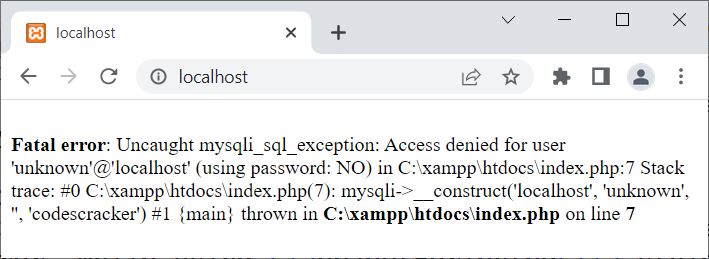- PHP Basics
- Learn PHP
- PHP Comments
- PHP Data Types
- PHP Variables
- PHP Operators
- PHP echo
- PHP print
- PHP echo vs. print
- PHP if else
- PHP switch
- PHP for Loop
- PHP while Loop
- PHP do...while Loop
- PHP foreach Loop
- PHP break and continue
- PHP exit()
- PHP exit() vs. break
- PHP isset()
- PHP Arrays
- PHP print_r()
- PHP unset()
- PHP Strings
- PHP Functions
- PHP File Handling
- PHP File Handling
- PHP Open File
- PHP Create a File
- PHP Write to File
- PHP Read File
- PHP feof()
- PHP fgetc()
- PHP fgets()
- PHP Close File
- PHP Delete File
- PHP Append to File
- PHP Copy File
- PHP file_get_contents()
- PHP file_put_contents()
- PHP file_exists()
- PHP filesize()
- PHP Rename File
- PHP fseek()
- PHP ftell()
- PHP rewind()
- PHP disk_free_space()
- PHP disk_total_space()
- PHP Create Directory
- PHP Remove Directory
- PHP Get Files/Directories
- PHP Get filename
- PHP Get Path
- PHP filemtime()
- PHP file()
- PHP include()
- PHP require()
- PHP include() vs. require()
- PHP mysqli Tutorial
- PHP mysqli Tutorial
- PHP and MySQL Setup
- PHP mysqli: Create Database
- PHP mysqli: Create Table
- PHP mysqli: Insert Record
- PHP mysqli: Update Record
- PHP mysqli: Fetch Record
- PHP mysqli: Delete Record
- PHP mysqli: SignUp Page
- PHP mysqli: LogIn Page
- PHP mysqli: Store User Data
- PHP mysqli Functions
- PHP mysqli_connect()
- PHP mysqli_close()
- PHP mysqli_connect_errno()
- PHP mysqli_connect_error()
- PHP mysqli_query()
- PHP mysqli_fetch_row()
- PHP mysqli_fetch_assoc()
- PHP mysqli_fetch_array()
- PHP mysqli_free_result()
- PHP mysqli_error()
- PHP mysqli_prepare()
- PHP mysqli_stmt_bind_param()
- PHP mysqli_stmt_execute()
- PHP mysqli_stmt_fetch()
- PHP mysqli_stmt_store_result()
- PHP mysqli_stmt_num_rows()
- PHP mysqli_stmt_bind_result()
- PHP mysqli_stmt_get_result()
- PHP mysqli_result class
- PHP mysqli_report()
- PHP error_reporting()
- PHP mysqli_real_escape_string()
- PHP htmlspecialchars()
- PHP Misc Topics
- PHP Object Oriented
- PHP new Keyword
- PHP header()
- PHP getallheaders()
- PHP Cookies
- PHP Sessions
- PHP Date and Time
- PHP GET vs. POST
- PHP File Upload
- PHP Image Processing
PHP connect_error and mysqli_connect_error()
This article is created to cover the two topics of PHP, namely:
Both return error descriptions (if any) from the last connection. The only difference is that connect_error uses PHP mysqli object-oriented script, whereas mysqli_connect_error() uses PHP mysqli procedural script.
PHP connect_error
The PHP connect_error is used when we need to get and print the error description raised by the last connection error while using PHP mysqli object-oriented script to connect to the database. For example:
<?php
$server = "localhost";
$user = "unknown";
$password = "";
$database = "codescracker";
$conn = new mysqli($server, $user, $password, $database);
if($conn->connect_errno)
{
echo "Database connection failed: ", $conn->connect_error;
exit();
}
$conn -> close();
?>
Since the user "unknown" is not available as a user on my MySQL database server. Therefore, the output produced by the above example is:

That is:
Fatal error: Uncaught mysqli_sql_exception: Access denied for user 'unknown'@'localhost' (using password: NO) in C:\xampp\htdocs\index.php:7 Stack trace: #0 C:\xampp\htdocs\index.php(7): mysqli->__construct('localhost', 'unknown', '', 'codescracker') #1 {main} thrown in C:\xampp\htdocs\index.php on line 7
Now, what I think is that you might expect the output to be something like:
Database connection failed: ...... // i.e., followed by error description
Therefore, let me be clear: the output you are watching was produced by default. To hide or suppress those fatal errors, you need to turn off error reporting using the following two statements:
$driver = new mysqli_driver(); $driver -> report_mode = MYSQLI_REPORT_OFF;
That is, here is the modified version of the above example:
<?php
$driver = new mysqli_driver();
$driver -> report_mode = MYSQLI_REPORT_OFF;
$server = "localhost";
$user = "unknown";
$password = "";
$database = "codescracker";
$conn = @new mysqli($server, $user, $password, $database);
if($conn->connect_errno)
{
echo "Database connection failed: ", $conn->connect_error;
exit();
}
// block of code to process further on successful connection
$conn -> close();
?>
Now the output should be:

Note: The @ before new is written to suppress the default error.
Note: The mysqli() function is used to open a connection to the MySQL database server in object-oriented style.
Note: The new keyword is used to create a new object.
Note: The connect_errno is used to get or return the error code (if any) from the last connect call in object-oriented style.
Note: The exit() function is used to terminate the execution of the current PHP script.
Note: The close() function is used to close an opened connection in object-oriented style.
Note: The mysqli_driver() function is used to modify the error reporting mode in object-oriented style.
PHP mysqli_connect_error()
The PHP mysqli_connect_error() is used when we need to get and print the error description raised by the last connection error while using the PHP mysqli procedural script to connect to the database. For example:
<?php
mysqli_report(MYSQLI_REPORT_OFF);
$server = "localhost";
$user = "unknown";
$password = "";
$database = "codescracker";
$conn = @mysqli_connect($server, $user, $password, $database);
if(mysqli_connect_errno())
{
echo "Database connection failed: ", mysqli_connect_error();
exit();
}
mysqli_close($conn);
?>
You will get the same output as the previous one, that is:
Database connection failed: Access denied for user 'unknown'@'localhost' (using password: NO)
Note: The mysqli_report() function is used to modify the error reporting mode in procedural style.
Note: The mysqli_connect() function is used to open a connection to the MySQL database server in procedural style.
Note: The mysqli_connect_errno() function is used to get or return the error code (if any) from the last connect call in procedural style.
Note: The mysqli_close() function is used to close an opened connection to the MySQL database in procedural style.
« Previous Tutorial Next Tutorial »